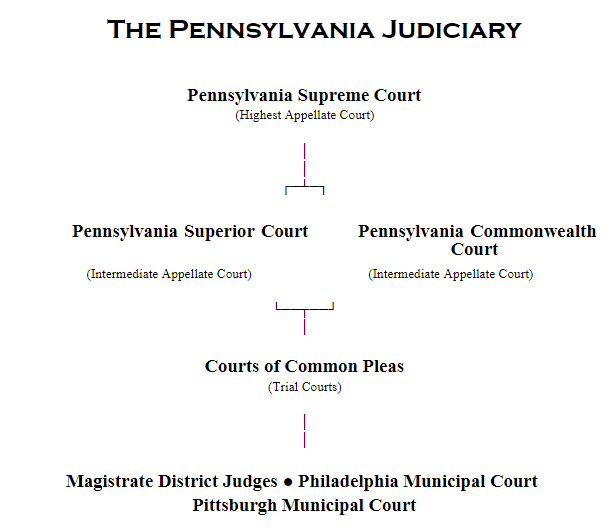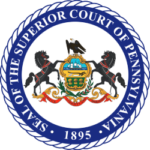
The Supreme Court of Pennsylvania
HISTORY
Established by the Judiciary Act of May 22, 1722, the Supreme Court of Pennsylvania is the oldest appellate court in the nation, predating the United States Supreme Court by 67 years. It is the highest court of the Commonwealth and the repository of the supreme judicial power of the state.
Since its creation, the court has experienced several changes in its structure, including the number of justices presiding, the appointment or election of justices, jurists’ qualifications and tenure, and the court’s jurisdiction. The 1722 Act established a court composed of one chief justice and two associate justices who would hold two court sessions a year in Philadelphia and ride circuit at other times to try cases throughout the colony. In 1767, the number of justices was increased to four. In 1809, the number was reduced from four to three. In 1826, it was increased again, this time to five justices; and in 1874, it was increased one more time, to seven, where it presently stands.
The Constitution of 1968, in establishing the Unified Judicial System, gave the Supreme Court broad supervisory and administrative powers over that system. Additionally, it fixed the tenure of justices at 10-year terms.
In 1980 the legislature approved a decrease in the Supreme Court’s mandated jurisdiction by expanding that of the Superior Court. Consequently, the Pennsylvania Supreme Court, like the United States Supreme Court, can now exercise discretion in accepting or rejecting appeals, allowing it to devote greater attention to cases of far-reaching impact, as well as to its constitutional obligation to administer the entire judicial system.
COMPOSITION
The Supreme Court of Pennsylvania is composed of seven justices elected to 10-year terms. The justice with the longest continuous service presides as Chief Justice. Vacancies on the court are filled by gubernatorial appointment, subject to Senate confirmation or by election.
JURISDICTION
The Supreme Court’s jurisdiction encompasses four main areas: original, appellate, exclusive, and extraordinary.
The Supreme Court holds original (but not exclusive) jurisdiction in cases of habeas corpus; mandamus, or prohibition to courts of inferior jurisdiction; and quo warranto concerning any officer of statewide jurisdiction.
The Supreme Court’s appellate jurisdiction includes those cases it hears at its own discretion and various types of cases heard as a matter of right. These latter cases include appeals of cases originating in Commonwealth Court and appeals of certain final orders issued by either the Common Pleas Courts or specific constitutional and judicial agencies.
The Superior Court of Pennsylvania
HISTORY
Pennsylvania’s Superior Court was created by the General Assembly in 1895 to ease the burden of the Supreme Court, thus giving Pennsylvania two appellate courts with separate jurisdictions. The Superior Court of Pennsylvania hears legal arguments in Philadelphia, Harrisburg and Pittsburgh. The main offices are in Philadelphia.
COMPOSITION
The original Superior Court was comprised of seven members. A constitutional amendment passed in 1979 increased this number to 15. There are usually at least five senior judges assigned to the Superior Court to assist with the heavy caseload.
JURISDICTION
Because the Superior Court’s main function is as an appeals court, its original jurisdiction is limited. Such jurisdiction includes mainly applications made by the attorney general and district attorneys under the Wiretapping and Electronic Surveillance Control Act.
The Superior Court of Pennsylvania is usually the busiest appellate court in the nation.
As an appeals court, the Superior Court’s jurisdiction is less specialized than the Commonwealth Court’s; therefore, it hears a wide variety of petitions, both criminal and civil, from Common Pleas Courts. Such petitions include all manner of cases, from child custody to armed robbery to breach of contract.
The Commonwealth Court of Pennsylvania
HISTORY
The Commonwealth Court came into existence on January 1, 1970, having been created by the Constitution of 1968. The Constitutional Convention intent was to create a court which would not only serve as a third appellate court, thus reducing the workload of the Supreme and Superior Courts, but also a court which would hear and try initial jurisdiction cases involving actions by or against the Commonwealth.
COMPOSITION
The resulting Commonwealth Court Act of 1970 provided for a court of seven judges, elected to 10-year terms. In 1980 an amendment to the Judicial Code increased the number of judges to nine.
JURISDICTION
Commonwealth Court has both original and appellate jurisdiction. Its original jurisdiction includes civil actions brought against the Commonwealth government or an officer of the government usually seeking equitable relief or declaratory judgment and not damages; civil actions brought by the Commonwealth government (note: these could also be brought in the Courts of Common Pleas); and matters under the Election Code involving statewide offices.
Its appellate jurisdiction includes appeals relating to decisions made by most state administrative agencies and appeals from the Courts of Common Pleas involving actions against the Commonwealth that could not be initiated in Commonwealth Court.
Courts of Common Pleas
HISTORY
The Courts of Common Pleas are Pennsylvania’s courts of general trial jurisdiction. They have existed in Pennsylvania at least since the Constitution of 1776, under which they received constitutional status.
COMPOSITION
The 67 counties are represented by 60 Judicial Districts. The size of trial courts are based upon the population and county class.
JURISDICTION
Courts of Common Pleas are general jurisdiction courts, which hear (1) all major criminal and civil cases, (2) appeals from the special courts in civil, criminal and traffic matters, and (3) most matters involving children and families, i.e., domestic relations cases.
Special Courts
JURISDICTION
The jurisdiction of special courts includes less serious, non-jury criminal and civil cases, and all traffic cases. Bail decisions are made at the time of preliminary arraignments. Determinations in serious criminal cases, such as high misdemeanor and all felony cases, as to whether the cases continue into the trial court, are made following preliminary hearings held before Magisterial District Judges.
